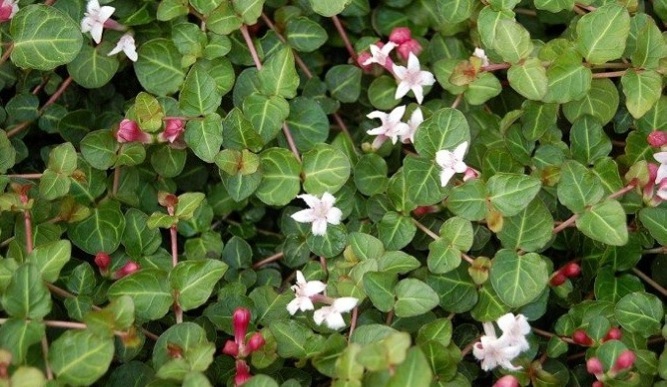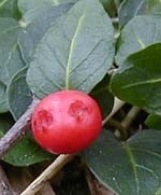Mitchella repens: Madder Berry
The Partridgeberry will not save you from starving but it can make your salad prettier and might keep you alive or ease your pain.
Partridgeberry, Mitchella repens (mit-CHELL-ah REP-enz) has its supporters and detractors, some call it insipid, others call it sour like a cranberry. My friend, forager Dick Deuerling, liked to use them to garnish salads. I found them juicy, if not messy, and very mild in flavor, nearly none. It has up to eight seeds and is nearly impossible to misidentify. There is also a version that grows in Japan. Besides a distinctive leaf, green with a yellow mid-vein, all partridge berries have two dimples because each berry grows from two hairy flowers. Not only does one berry come from two flowers but one flower has a short pistil and long stamens and the other a long pistil and short stamens. They should have called it the Mirror Berry. The plant flowers between April and June and sometimes again in the fall. The berries ripen from July to October and because they are low in fat often persist for several months if not snatched by woodland creatures.
By far the greater calling of the Partridgeberry in North America has been medicinal. A tea from the leaves has a very long and extensive history for easing childbirth and menstrual cramps. That tea is also diuretic, which can lower blood pressure. In the Madder family, the genus Mitchella honors John Mitchell, 1711-1768, a Virginia botanist who actually misidentified the M. repens. Repens means low growing. M. repens is a vine that does not climb. It does make an excellent ground cover. The berry is favored by the ruffed grouse hence the name Partridgeberry. It was also called Squaw Vine for its use by women.
Green Deane’s “Itemizing” plant profile
IDENTIFICATION: A low-growing non-climbing vine often found under leaf litter in deciduous forests. The fruit is a bright red berry, oval, 1/4 to 3/8 inches across, persist through the winter if not eaten. Never abundant. Flower half- inch long, four or five white to faint pink fuzzy petals, appearing mid-summer. Leaves opposite, evergreen, oval to heart-shaped, half inch across, parallel veined, dark green above with a paler yellow-green midrib, pale yellow below.
TIME OF YEAR: Depending upon climate, July to October
ENVIRONMENT: Moist woods, usually among trees that lose their leaves in winter.
METHOD OF PREPARATION: Trail side nibble, salad garnish, sauces, pies and jams. Use like cranberries. Leaves and berries make herbal teas of various applications.





Found several today while on the Willie Brown trail and timucuan trail. Not much taste with the consistency of a potato or soft apple.
This was one of my favorite plants when I was a little kid. Though I didn’t know the berries were edible, I have fond memories of being down in the forest undergrowth admiring the fuzzy little 4 petaled flowers. What a treat to know I can eat them too!
Hello. Thank you for the information on this wonderful plant. We have lots of it growing in the woods near our home and I have often wondered what it was. I’m sure the wild turkeys that roam our pastures must eat it from time to time. It’s great to know it’s edible, just in case my curious kiddos decide to nibble on them. Thanks again!
Found some up on Poetry Ridge, Greenfield, MA… not bad, especially when you need a few calories to make it back, lol !
The most of these I ever found was a particularly prolific patch in North Jersey along the Delaware Water gap. A friend and I stumbled across a wide area of them in a moist section of path and they had several dozen berries. Unlike most I’d found up to that point, these were a bit sweet, and so we nibbled on a handful of them, spitting out the seeds everywhere to ensure they were well-spread!
No one has mentioned the beautiful vanilla fragrance these blossoms produce.
Contrary to all of the wonderful things said about this plant, in my case it is a “misplaced plant” otherwise to me a weed that intertwines in my moss carpeted yard. Due to its habits, it is extremely difficult to control by hand, perhaps the most difficult weed to control in moss. Unlike everyone else, I wish to eradicate it. Any suggestions? Thank you.
After I originally commented I clicked the -Notify me when new comments are added- checkbox and now every time a comment is added I get four emails with the identical comment. Is there any way you’ll be able to remove me from that service? Thanks!
I can’t see the post or any way to change what is happening.